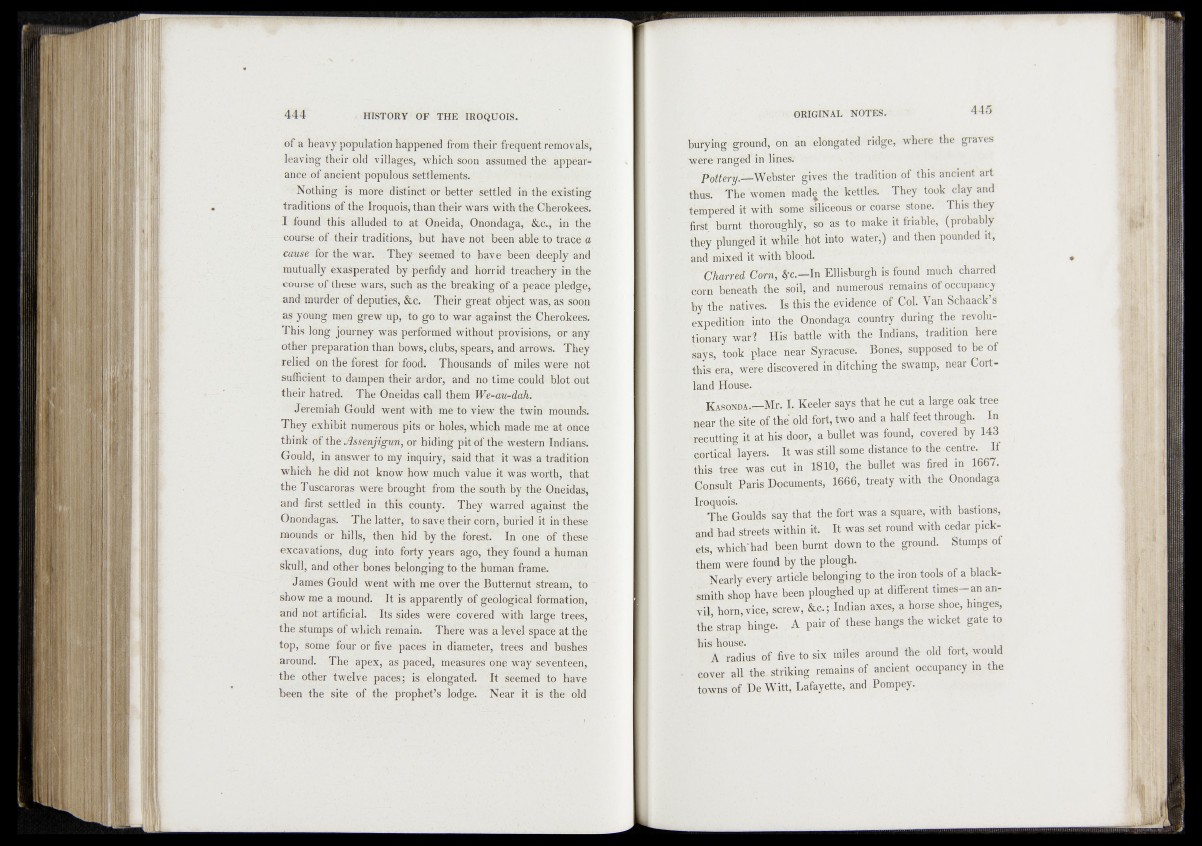
of a heavy, population happened from their frequent rmov§}4
leaving' their 'did villages, wh ich'Soon. assumed the' appearance
.of ancienf popülaük«ettléments. ^
Nothing is rnaofe distinct ’ur better settled in the existing
traditions of the Iroquois, than their wqrs with the Cherokëfes.
I found this alluded to at Oneida, Onondaga, &c., in the
^ot^è;©Lf heir-traditi.ons^ but have not "been able to trace (t
cause for the-war. ~ They-seemed to have‘ beenv deeplyapd
mutually exasperated by-perfidy and horrid treachery in;the
course of these wars, such as the breaking of a peabë pledge,
and murder of deputies, &c. Their great object wjas] as soon
as'young men grew up, 4b g a to war against thé Öhterökees.
This long journey Was performed withoüt provisions, or any
other preparationthan bows, ckfbSyilpears, and-arrows. They
relied on the forest for-food, 'thousands of miles were not
sufficiënt td dampen their ardor, and'-no time could .hibtJOUt
their.-hatred.’ The Oneijias-èall them We-cmrdah; -
Jbremiah Gould went with me f@ view the twin' mounds*
They exhibit numerous pits ©r, holes, which made Tneat- once
think o’f the Jksenjégwrl, or biding pitfi^Sthe western Indians.1
Gould, in answer: to my inquiry; said that 'it was1 a. tradition
which he did not know how much value it was* worth, that
the Tuscaroras were brought from the.south by'-fhe Oneidas,
and 'first settled in this ^county. They „wafred against the
OnondagaS. The latter, to sa’v^fheiric^n, bulled it in‘these
mounds or hills, then hid by the* forëét.? In "pine -of these
excavations, dug into forty y e a r s " t h e y fofibd a human
skull, and other bones belonging to the human frame.
James'Góuld wént with me over the Butternut stream, to '
show me a mound. It is apparently of geological formation,
and not artificial. Its sides were edverèd with large trees,
the stumps of which remain. There vyas a level space at the
top, Some four or five .paces in diameter, treqs and' böshes
-around. The apex, as paced, measures qne. way seventeen,
the other twelve paces; is,, elongated. It seemed to have
been the site of the ptophet’s lodged Neat' it is the old
buiying ground, on. an elongated ridge, where the graves
were ranged in lines/
' 'j4)^ty'.i-WebSfof gives the tradition pf this ancient art
thus. The wbmfen ma3^ the kettles. They took clay and
tempered'it witli'soJteVsiliceeuI'Or coarse stone.' This they
~fi?st -burnt' thoroughly, so' as to make it friable, (probably
$hey whiles hOt into water*,) and then pounded it,
and mixed it with blbod.
f 'CMrrUAtyUn4% fyc.-—ln KllisbuTgVis found much charred
' iorn ben%th the ^sbif1 and* nufoerotfg'remains of occupancy
the natilesA * Is'fjus the bvfde'txce of Col. Van Schaack’S
e^pe^Mom into the B R H l country during the revohl-
Tionaty w f i f ' His',battle with the Indian's, tradition here
^ y s^ -took '-Mace'nea? Syracuse? Bones, supposed to be of
this e^,,w5Sdiscovered in pitching the sw'mdp, near Cort-
rapdt^fouse.
' Kasonda—Jdr. I. Keeler’says that he" cut a large oak tree
pear the site joffbe old* fort, -two and a half feet through. In
p u ttin g , it at his door, a bullet was .found, covered by 143
cortical layers ^ It, was still some distance to the centre. If
this free yas.qut ip l8;ipr the bullet was fired in 1667.
Consult Paris,Documents, 1666, treaty with the Onondaga
Iroquois. - | | .
qpke Goulds say.fhat &e fort“was a square, with bastions,
and bad starts within it. ( It wa? set round with cedar pickets,
which'had been, burnt down to the „ground. Stumps of
them Were foundry the plough. - . * f
Nearly every article belonging to the iron tools of a blacksmith
shop have been ploughed up at different times-an an-
wil, horn-,-vice, screw, &e.; Indian axes, a horse shoe, hinges,
the’ strap hinge. A pair'of these hangs the wicket gate to
his-house.
A radius of five to six miles around file old fort, would
covet all the. striking .remains of ancient, occupancy in the
towns of De Witt, Lafayette, and Pompey.